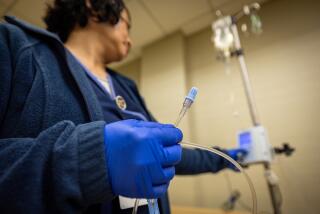Drug Offers Hope to Victims of Alzheimer’s
Doctors in Los Angeles have found an experimental drug against Alzheimer’s disease that significantly improved the memory and living skills of a small group of patients for up to a year or more, it was announced today.
In a report in this week’s New England Journal of Medicine, the team of researchers from the UCLA department of psychiatry and Huntington Memorial and Las Encinas hospitals in Pasadena say the degree of improvement in their patients “has often been dramatic.”
“One subject was able to resume most of her homemaking tasks, one was able to resume employment on a part-time basis, and one retired subject was able to resume playing golf daily,” they reported. In other cases, they noted improvements “in activities of daily living, such as self-feeding at the family table, where total care had previously been required.”
Further Testing Needed
But they cautioned that the drug is not a cure for Alzheimer’s and must undergo further testing to verify the initially promising results before the U.S. Food and Drug Administration might approve it for general use.
In eight of the 17 patients in the study, the drug caused side effects that included nausea, belching, excessive urination and sweating and diarrhea. In addition, the drug may cause liver, blood and nerve toxicity because it comes from a family of chemical known to have those effects in the long term, the investigators reported.
But considering the devastating nature of Alzheimer’s, coupled with the promising long-term effects of the drug on 12 patients who have received it to date, the researchers said they feel the drug study should be broadened to include more patients.
Alzheimer’s is a slowly progressive neuropsychiatric disorder that leads to profound memory loss, neurological impairment and death in six to 12 years for an estimated 1.5 million to 3 million Americans, most of them the elderly. The cause is unknown, and no therapy to arrest the deterioration is available.
The drug, called tetrahydroaminoacridine or THA, was first synthesized 77 years ago. But the obscure drug was not explored for clinical use in Alzheimer’s until the late 1970s when Dr. William K. Summers, an Arcadia psychiatrist and the principal investigator in the study, began using it to treat dementia.
24 Originally in Study
In 1984, Summers and Drs. Arthur Kling, Kenneth Tachiki and Lawrence Majovski of UCLA and Sepulveda Veterans Administration Hospital, began treating 24 suspected Alzheimer’s patients with THA in a scientifically designed study.
Alzheimer’s cannot be diagnosed with certainty until autopsy. Therefore, in the first phase of that study, seven of the 24 patients were eliminated because tests indicated that they had other kinds of dementia, but not Alzheimer’s. Five others were eliminated from the study because they had other conditions in addition to Alzheimer’s that would have complicated the evaluation of test results.
The remaining 12 patients generally showed significant improvement in mental functions after receiving THA tablets. When they were given a placebo, or an inactive sugar pill, without their knowledge, their mental functions deteriorated. During both the THA and the placebo phases, the patients were given special tests designed to measure memory, orientation and other brain functions.
“If this is validated, I think we will have our first viable treatment for Alzheimer’s,” Summers said.
Study Is Ongoing
The study is still ongoing, with the patient longest in therapy having received THA for 26 months. Two of the patients responded initially to THA, but their mental state began to deteriorate despite the drug at 17 and 7 months, respectively, the report said.
THA was selected for the study as the result of research in 1976 by other scientists indicating that the mental deterioration of Alzheimer’s results from the deficit of an enzyme in the brain that is responsible for the formation of an important chemical known as acetylcholine.
Acetylcholine is involved in transmitting nerve impulses. THA is believed to replace the missing enzyme, thereby improving the brain’s ability to function normally.
However, in an editorial accompanying the article, Drs. Kenneth L. Davis and Richard C. Mohs of Mount Sinai Medical School in New York point out that Alzheimer’s is not simply a disease caused by the deficit of a single neurotransmitter. As the disease progresses, they said, therapy involving a single enzyme will stop being effective.
Kling said the group plans eventually to investigate the mechanism of action of THA, possibly combining it with other neurotransmitters in order to produce a broader therapy.
‘Fee-for-Service Research’
He described the present study as “fee-for-service research,” in which patients who stand to benefit from an experimental treatment agree to pay the cost of providing it. The current cost is $12,100 for the first year and $4,800 for the second year, according to Summers.
Meanwhile, research to find the cause of Alzheimer’s, develop improved treatments and broaden the understanding of the disease are continuing at a number of other laboratories across the country.
Earlier this week, Dr. Peter Davies of New York’s Albert Einstein College of Medicine reported identifying an abnormal protein in the brain and spinal fluid of Alzheimer’s patients that may be the first accurate diagnostic indicator for the disease in living patients.






